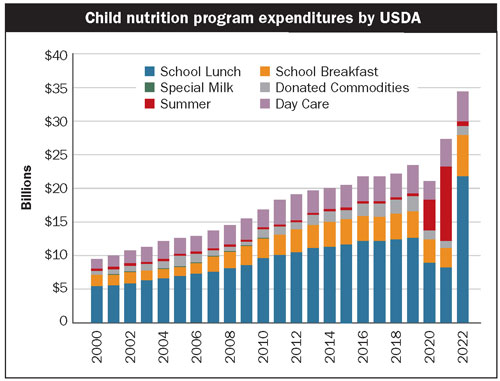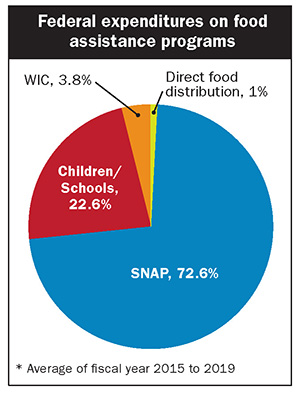
It is once again the twice-in-a-decade season for writing a new “farm bill.” Every time this exercise starts anew, we are reminded somewhere along the way that there are a lot of things in a farm bill that don’t have anything to do with farming . . . at least directly.
About the same time the new farm bill will be kicking in this October, the federal government’s new fiscal year also will be underway. This fiscal focus is important as the Congressional Budget Office projects that about 72.5% of all USDA expenditures will be related to food assistance programs. On the flip side, the U.S. Forest Service, which is the largest single employer within USDA, is expected to represent less than 5% of the USDA budget.
There are many food assistance programs. The figure shows recent, prepandemic expenditure shares for four large categories of food assistance programs. The most commonly recognized specific programs are: SNAP, 72.6%; National School Lunch, 22.6%; WIC, 3.8%; and TEFAP, 1%.
A deeper understanding
The Supplemental Food Assistance Program (SNAP) is the single largest food assistance program. On an annual basis, more than 40 million people received these food assistance subsidies over the last 10 years. Just as all food assistance programs represent almost three quarters of total USDA expenditures, almost three quarters of food assistance expenditures are budgeted to SNAP.
The Emergency Food Assistance Program or TEFAP is the largest of several programs by which USDA actually acquires or pays for the acquisition of food products that are distributed primarily through food banks and other such food distribution networks for low income and needy families. Average annual expenditures for TEFAP are about $600 to $700 million. The number of people who benefit can only be estimated as the food is distributed through private organizations, but Feeding America, the largest of these, estimates TEFAP helped them deliver a billion meals last year.
The National School Lunch (NSL) program is the largest of several distinct programs aimed at providing healthy foods to needy children. In addition to NSL, there are smaller programs that have similar goals: the School Breakfast Program, the Summer Service Program, the Children and Adult Care Food Program, and the Special Milk Program. Specific expenditures are shown on page 249. The National School Lunch program subsidizes the cost of school feeding programs for about 30 million children a year, or about three quarters the number of people covered by SNAP, at a cost of about $22 billion.

A program particularly near and dear to the dairy industry is the Special Supplemental Nutrition Program for Women, Infants, and Children (WIC). This program is intended to provide key nutritional requirements for low income pregnant and lactating women and their young children. By the nature of the product and the specific nutritional needs of these two populations, a very large share of WIC expenditures goes to milk and other dairy products.

At one time, carefully selected foods were delivered in packages to eligible people. Today, most “nutritional packages” are actually received as a voucher or electronic debit card that can be used to buy very specifically defined foods that meet the WIC dietary guidelines.
Over 6 million people are helped by WIC. Total expenditures under this program average a bit less than $6 billion per year, but about $2 billion is allocated to educational and health care programs aimed at helping expectant and young moms improve their health and the health of their babies.
Why the connection?
Okay, so there are all these food assistance programs run by USDA. Why are these food programs mixed in with the farm bill? Doesn’t this mean farmers have to compete with consumers for limited farm bill funding?
There are two key considerations.
The first is economic or monetary. The budgetary starting point for funding of farm bill programs in Congress is how much was spent on previous farm programs. If food assistance was stripped out of the bill, its budgeted funding would go with it.
The second is political. As anyone who has worked closely on the development of a farm bill will tell you, it gives members of Congress who primarily advocate for rural areas and farmers a lot more leverage to negotiate the package of programs with members of Congress who advocate primarily for consumers — most of whom live in cities — than if they had to stand alone.
Among the 435 seats in the U.S. House of Representatives, about 73, or one out of six, represent strictly rural areas. Having the nation’s food assistance programs administered by USDA gives farmers and their closely related businesses communities a more prominent voice.
Yes, it may mean having to compromise on what the farm community originally desired, but the risk is not getting anything you asked for. Political compromise and negotiation seems to be falling out of favor as of late, but congressional observers frequently note that has long been a hallmark on the congressional committees that represent agriculture. That’s a good thing.






